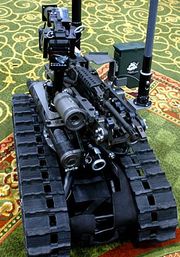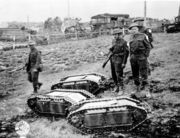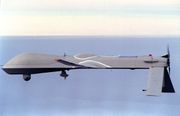 | | __ |
|
| Today is |
|
MILITARY
ROBOTS
|
|
Military robots are autonomous or remote-controlled devices designed for military applications.
Such systems are currently being researched by a number of militaries. Already remarkable success has been achieved with unmanned aerial vehicles like the Predator drone, which are capable of taking surveillance photographs, and even accurately launching missiles at ground targets, without a pilot. A subclass of these are Unmanned Combat Air Vehicles, which are designed to carry out strike missions in combat. History & Developments
the combat version of the Foster-Miller TALON, SWORDS.
Broadly defined, military robots date back to World War 2 and the Cold War in the form of the German Goliath tracked mines and the Soviet teletanks. However, these were simple and made little real impact on the war. It was not until the war in Afghanistan and the Second Iraq War that military robots became more than a footnote. Since then, they advanced rapidly. Defense contractors in the USA are hard at work developing autonomous "robot soldiers", but most current models look more like tanks than humans. There are problems with threat recognition and response; some models will not shoot cows with guerillas crouched behind them, but will fire at anything stenciled with an AK-47 silhouette. In December 2003, the Associated Press reported that The Pentagon had purchased several Segways, as part of a research program called "Mobile Autonomous Robot Software", an attempt to develop more advanced military robots. Examples of systems in development
Issues There are many advantages in robotic technology in warfare however, as outlined by Major Kenneth Rose of the US Army's Training and Doctrine Command{2]: "Machines don't get tired. They don't close their eyes. They don't hide under trees when it rains and they don't talk to their buddies ... A human's attention to detail on guard duty drops dramatically in the first 30 minutes ... Machines know no fear." However, even so, military robots face a variety of issues, many of which are not even remotely a problem for human soldiers. Friendly fire Because AI is not sufficiently advanced enough to prevent friendly fire, researchers continue to stress the importance of keeping a human in the loop. One Internet rumor about friendly fire emerged when funding for the US Army's machine-gun-equipped SWORDS was pulled. According to the Army's Program Executive Officer for Ground Forces, Kevin Fahey, "The gun started moving when it was not intended to move". Rumors quickly massed about the robots turning on their comrades and their subsequent suppression. [3] However, the story proved unsubstantiated. [4]
Computer games
References External linksOrganizations
News articles/Press releases
|
HISTORY OF ROBOTS -- ROBOTS IN SPACE -- ROBOTIC SURGERY -- ROBOTS IN THE MILITARY -- MORE -- Basics -- Robotics Robotics in Space Robotics in Medicine Robots in the Home Robots in the Military |

